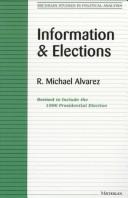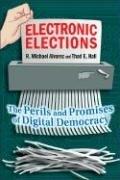| Listing 1 - 5 of 5 |
Sort by
|

ISBN: 1282604554 9786612604553 0472022377 9780472022373 0472085751 9780472085750 Year: 1997 Publisher: Ann Arbor : University of Michigan Press,
Abstract | Keywords | Export | Availability | Bookmark
 Loading...
Loading...Choose an application
- Reference Manager
- EndNote
- RefWorks (Direct export to RefWorks)
Presidents --- Voting --- Political campaigns --- Communication in politics --- Election.
Book
ISBN: 1282531565 9786612531569 1400834678 9781400834679 9780691154350 069115435X 9780691143057 0691143056 9781282531567 Year: 2010 Publisher: Princeton, NJ
Abstract | Keywords | Export | Availability | Bookmark
 Loading...
Loading...Choose an application
- Reference Manager
- EndNote
- RefWorks (Direct export to RefWorks)
Making up 14.2 percent of the American population, Hispanics are now the largest minority group in the United States. Clearly, securing the Hispanic vote is more important to political parties than ever before. Yet, despite the current size of the Hispanic population, is there a clear Hispanic politics? Who are Hispanic voters? What are their political preferences and attitudes, and why? The first comprehensive study of Hispanic voters in the United States, New Faces, New Voices paints a complex portrait of this diverse and growing population. Examining race, politics, and comparative political behavior, Marisa Abrajano and R. Michael Alvarez counter the preconceived notion of Hispanic voters as one homogenous group. The authors discuss the concept of Hispanic political identity, taking into account the ethnic, generational, and linguistic distinctions within the Hispanic population. They compare Hispanic registration, turnout, and participation to those of non-Hispanics, consider the socioeconomic factors contributing to Hispanics' levels of political knowledge, determine what segment of the Hispanic population votes in federal elections, and explore the prospects for political relationships among Hispanics and non-Hispanics. Finally, the authors look at Hispanic opinions on social and economic issues, factoring in whether these attitudes are affected by generational status and ethnicity. A unique and nuanced perspective on the Hispanic electoral population, New Faces, New Voices is essential for understanding the political characteristics of the largest and fastest growing group of minority voters in the United States.
Voter registration --- Voting registers --- Voting research --- Hispanic Americans --- Elector registers --- Electoral rolls --- Poll books --- Poll lists --- Pollbooks --- Registers, Voting --- Voter lists --- Voter registers --- Voters lists --- Voters registers --- Voting --- Lists --- Voting behavior research --- Elections --- Cross-cultural studies. --- Politics and government. --- Research --- Latin Americans --- Latinxs --- Ethnology --- Politics and government

ISBN: 1282531468 9786612531460 1400834082 9781400834082 0691146225 9780691146225 0691125171 9780691125176 9780691146225 9781282531468 6612531460 Year: 2008 Publisher: Princeton Princeton University Press
Abstract | Keywords | Export | Availability | Bookmark
 Loading...
Loading...Choose an application
- Reference Manager
- EndNote
- RefWorks (Direct export to RefWorks)
Since the 2000 presidential election, the United States has been embroiled in debates about electronic voting. Critics say the new technologies invite tampering and fraud. Advocates say they enhance the accuracy of vote counts and make casting ballots easier--and ultimately foster greater political participation. Electronic Elections cuts through the media spin to assess the advantages and risks associated with different ways of casting ballots--and shows how e-voting can be the future of American democracy. Elections by nature are fraught with risk. Michael Alvarez and Thad Hall fully examine the range of past methods and the new technologies that have been created to try to minimize risk and accurately reflect the will of voters. Drawing upon a wealth of new data on how different kinds of electronic voting machines have performed in recent elections nationwide, they evaluate the security issues that have been the subject of so much media attention, and examine the impacts the new computer-based solutions is having on voter participation. Alvarez and Hall explain why the benefits of e-voting can outweigh the challenges, and they argue that media coverage of the new technologies has emphasized their problems while virtually ignoring their enormous potential for empowering more citizens to vote. The authors also offer ways to improve voting technologies and to develop more effective means of implementing and evaluating these systems. Electronic Elections makes a case for how e-voting can work in the United States, showing why making it work right is essential to the future vibrancy of the democratic process.
Voting-machines --- Electronic voting --- Ballot --- Elections --- E-voting --- eVoting --- Voting --- Reliability. --- Security measures --- Equipment and supplies --- #SBIB:324H42 --- Reliability --- Politieke structuren: verkiezingen --- Political systems --- Computer. Automation --- United States --- United States of America
Book
ISBN: 131632284X 1316309460 1316326187 1316329526 1316332861 1107690153 1316319482 1107706084 1316288757 1107068835 1316316149 9781316319482 9781107706088 9781107068834 Year: 2015 Publisher: New York, NY
Abstract | Keywords | Export | Availability | Bookmark
 Loading...
Loading...Choose an application
- Reference Manager
- EndNote
- RefWorks (Direct export to RefWorks)
Over the years, observers of American politics have noted the deleterious effects of party polarization in both the national and state legislatures. Reformers have tried to address this problem by changing primary election laws. A theory underlies these legal changes: the reformers tend to believe that 'more open' primary laws will produce more centrist, moderate, or pragmatic candidates. The 'top-two' primary, just implemented in California, represents the future of these antiparty efforts. Nonpartisan Primary Election Reform examines California's first use of the top-two primary system in 2012. R. Michael Alvarez and J. Andrew Sinclair evaluate the primary from a variety of perspectives and using several different methodologies. Although the first use of this primary system in California did not immediately reshape the state's politics, it also did not have many of the deleterious consequences that some observers had feared. This study provides the foundation for future studies of state primary systems.
Primaries --- Election law --- Political parties --- Polarization (Social sciences) --- Right and left (Political science) --- Left (Political science) --- Left and right (Political science) --- Right (Political science) --- Political science --- Social groups --- Social influence --- Direct primaries --- Elections, Primary --- Presidential primaries --- Primary elections --- Elections --- Nominations for office
Book
ISBN: 9781139226547 9781107027626 9781107653054 9781139776936 1139776932 9781139782968 1139782967 1139226541 1107027624 1107653053 1139794337 1316090205 1107254779 1139779974 1283818035 1139778455 Year: 2013 Publisher: New York Cambridge University Press
Abstract | Keywords | Export | Availability | Bookmark
 Loading...
Loading...Choose an application
- Reference Manager
- EndNote
- RefWorks (Direct export to RefWorks)
In competitive and contested democratic elections, insuring integrity is critical. Evaluating Elections shows why systematic analysis and reporting of election performance is important and how data-driven performance management can be used by election officials to improve elections. The authors outline how performance management systems can function in elections and their benefits for voters, candidates and political parties. Journalists, election administrators and even candidates often ask whether recent elections were run well, whether there were problems in the administration of a particular state's elections and how well elections were run across the country. The authors explain that such questions are difficult to answer because of the complexity of election administration and because there is currently no standard or accepted framework to assess the general quality of an election.
Elections --- Electoral politics --- Franchise --- Polls --- Political science --- Politics, Practical --- Plebiscite --- Political campaigns --- Representative government and representation --- Social Sciences --- Political Science
| Listing 1 - 5 of 5 |
Sort by
|

 Search
Search Feedback
Feedback About UniCat
About UniCat  Help
Help News
News